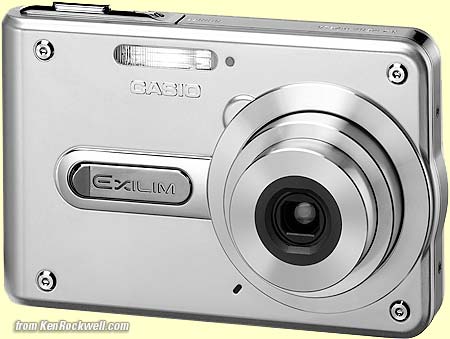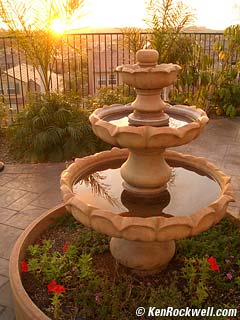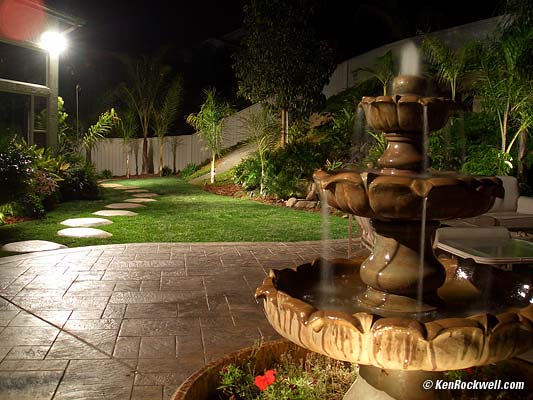Home Search Gallery How-To Books Links Workshops About Contact
|
PERFORMANCE back to first page and index Lens Focusing White Balance ISO Settings Flash Sharpening, Saturation and Contrast Settings Image Quality LENS back to performance back to first page and index The lens is a 4.8 - 13.5 mm f/4.0 - 6.6, similar to about a 36 - 102 mm lens on a 35mm film camera. Contrary to popular belief, the lens has little to do with the performance of a digital camera. Digital cameras have performance limited by the resolution of the CCD sensor and rarely by the lenses. It has a transparent ceramic element with a very high refractive index to allow great miniaturization. It's a brilliant work of design, it's tiny and works as well as larger lenses. Like most digicam zooms it only zooms in seven steps. You cannot zoom continuously. The seven steps are: 4.8
mm f/4.0 This kind of makes me laugh: most digital cameras zoom only in steps optically where you'd need it, but the digital zoom you don't want to use usually works continuously. Sharpness Like most digital camera lenses it's as sharp as it can be in the center and almost everywhere at all focal lengths. It's so sharp it can cause aliasing. Mine was sometimes soft in the far lower right corner at the wide end, which you'd only notice if you deliberately looked for it. This is common in this class of camera. Want to know how sharp it is? In the course of reviewing my test shots I clearly noticed a swarm of gnats backlit against the sunset. I hadn't noticed them while shooting! 4.8
mm f/4.0: Sharp center, soft lower right It's as sharp as other cameras; there isn't as much variation between them as marketeers try to imply. It's not as sharp in the corners as my much-better-than-average Canon A70 which is a small price to pay for a miniature camera that will be with you while a bigger camera is left at home. This softness isn't something you'll see unless you're deliberately looking for it; the S100 makes great huge prints. If you only photograph brick walls this isn't the best camera since it's softer at the sides and corners. Distortion Like almost every digital camera, it has barrel distortion at the wide end and little or no distortion in the mid and telephoto portions. 4.8
mm: plenty of barrel distortion (typical for zoom cameras) Flare and Ghosts Quite good. I couldn't get ghosts or flare shooting into the sunset.
The red spots are flowers, not ghosts. Note the nice warm look from the Shade White Balance that many cameras lack. If you try really hard you can get a red blob further towards the frame edge if you have a bright light source close to the edge.
The red blob at the upper right is the only flare you'll get if you have a bright light source there. The way to fix this simply is to point the camera a little more to the right or to dodge the light with your hand during the four second night exposure. FOCUSING back to performance back to first page and index Auto Focus The Autofocus system has zones arranged in a central horizontal band. Casio claims seven zones; if so they are pretty close together. I'd prefer a broader range of zones like Canon uses with zones also arranged vertically. The S100 works as well or better than as other digital point and shoots, which means it's fine for still subjects and useless for moving kids and pets. The S100 is actually pretty fast as point and shoots go. The focus indicator brackets on the LCD are usually white. They turn green when and where focused or red if it couldn't focus. Likewise the green light on the back of the camera glows solid green if all is OK, or flashes green if not. There is no AF assist beam, so you're out of luck in the pitch black. It would be nice to have one, then again, these annoy the heck out of people being photographed anyway. In conditions as dark as the yard above (4 second exposure) it works fine without assistance. Macro Focus Macro is typical. You can get as close as seven inches (17 cm) at any focal length. This gets you this close at the telephoto setting:
Closest focus at telephoto setting OK, it's better than most since you can get that close at all focal lengths. Many cameras, like my Canon A70, can't focus close at the telephoto setting. Also if you focus on a distant subject while in the macro mode the S100 automatically reverts to the regular mode; unlike my Canon A70 which won't focus to infinity from the macro mode. Testing this all for myself I see the Casio EX-S100 focuses from 7" to infinity in both the macro and regular AF settings. I see no difference between the two, which is great! Instant Focus Mode (also called Pan Focus or Hyperfocal mode) The S100 is brilliant. If you press the shutter all the way down before it can autofocus it simply defaults instantly to the hyperfocal distance and you get your shot. This works great since everything from about three feet is in focus. You won't miss shots because the camera couldn't autofocus. This mode gets twice as much in focus as an infinity setting. Digital cameras have huge depths of field so this works great. If you prefer you can always shoot at this setting. It's called "pan focus" and labeled"PF" among the focus modes. Of course the usual autofocus (no symbol), manual focus (MF), macro (flower), and infinity (lazy eight) modes are there. The camera defaults to this PF setting if you release the shutter before the autofocus system completes focusing. If you'd prefer instead that the camera locks up until it gets perfect autofocus you can turn this off in the record menu under "Auto PF." Default is ON, turn it to off if you don't want it to default to PF if you press the shutter too fast. In PF mode cyan letters in the upper right of the LCD show the exact range in focus. This range varies with zoom setting and ambient light. I only saw it read in meters, not feet. A meter is about a yard or three feet. WHITE BALANCE CONTROLS back to performance back to top General Excellent! This Casio is probably the best and fastest camera I've used for setting white balance. It has all the settings one needs and they are easy to set. The Cloudy setting is better than other cameras. Casio's Cloudy setting is similar to the popular Cloudy - 3 setting used by many professionals on their Nikons. It really warms up cloudy days. On most cameras, including professional Nikons, the cloudy setting isn't much different than the daylight setting and therefore useless unless you tweak it warmer. This is another sign that a photographer actually designed this Casio. If not using Auto, I use the Daylight, Cloudy and Shade settings to give me the equivalent of three important levels of warming filter. This Casio has no ability to tweak each preset with +- values as one may on Nikon DSLRs. You may set the left and right command keys to select instantly among white balance settings. Just go to the REC menu and use the last setting called "L/R Key." I've seen no camera, even DSLRs, that have a direct entry like this. Even my favorite DSLRs still have a button to hold while spinning a knob, requiring two hands. Manual White Balance (MWB) Manual White Balance (setting to a gray card) is the best I've ever used on any camera regardless of price. The S100 easily balances across the entire range from extreme blue skylight to dark dingy home tungsten lighting as well as bizarre things like high pressure orange sodium street lights, pink restaurant lights and green and magenta or whatever light! That's right: you can set it so far that you can make home tungsten lighting, usually about 2,800 K, even look deliberately blue and you can make things under yellow street lights look normal, which is better than they do in person! This is great, I haven't been able to get my Nikon to do this. Not only is it wide ranged, it's also very accurate on the first try. It's also very easy to set. I figured it out just by picking up the camera, no manual required. Contrast this to my Nikon DSLRs which usually require the book to figure out. The only caution is that since the camera has the range to white balance under even light that is not white, like orange street lights, that the camera may have to increase the gain in some color channels a lot which could lead to noise. Specifically, since orange street lighting has no blue the camera has to increase the sensitivity of the blue channel a huge amount to make things look normal. The huge increase required in blue sensitivity will lead to a lot of noise in the blue channel, meaning you will see blue snow in the dark parts of the image. If you really want to make things lit by orange street lights look like they're under white light then remember to use a tripod and ISO 50. This is a good thing; other cameras simply lack the huge range of adjustment the Casio has so you don't have the freedom to get the problems that come with it. It balances fine under high pressure sodium (HPS) lighting, which is very impressive since nothing else will. I have not tried it under low pressure sodium (LPS) lighting, the deeper orange kind, and doubt that it can. This is because LPS is a single monochromatic wavelength of orange light so no colors can be seen under it. LPS lights make everything look orange and red look black. HPS is the less orange whiter kind of yellow street lighting. It has more than just one color in its spectrum thus you can see a little bit of color differentiation under it. Again, this S100 can white balance so well that it can things under HPS yellow light look as if they are in white light, cleaner then they look to the eye. Oddly in iView Media Pro shots made with manual (gray card) white balance read as "auto," at least when transferred directly and not read through Casio's software. Double bravo, this is better than any other kind of camera I've used. I'm really impressed! ISO SETTINGS back to performance back to first page and index ISO and Auto ISO Settings The ISO is correct. ISO 50 looks the same as film exposed at ISO 50, so take the camera's exposure at face value for use as a light meter. The Auto ISO setting works much better than most cameras. It starts increasing ISO as soon as the shutter starts to slow. When it gets too dark at ISO 200 at 1/8 then you get underexposure, so watch out since you need to choose another mode that allows longer shutter speeds. Most Auto ISO settings in other cameras only take effect with flash; the S100 works perfectly for available light. Auto ISO often kicks in to bump you up to ISO 100 or ISO 200 when the shutter speeds otherwise would get slow. Auto ISO only runs up to ISO 200, since ISO 400 looks awful just like most compact cameras. FLASH back to performance back to first page and index The tiny flash works fine. It also works great at close distances and doesn't overexpose as many cameras do. It also does a better than average job of balancing with ambient and back light. Flash sync goes all the way up to 1/2,000 of a second due to the electronic CCD shutter. This is much better than any of today's DSLRs. It can take up to ten seconds to recharge the flash after a full power dump, or much quicker at closer distances. I'd like a faster recycle time, but to get that you'd need a bigger battery. In addition to the usual automatic ISO boosting for distant subjects, the S100 has an additional magic "Flash Assist" mode. This mode lightens the image after it's shot if you didn't have enough range. You set it to "auto" in the REC menu if you want it (I'd suggest it), although the default is off. SHARPENING, SATURATION and CONTRAST SETTINGS back to performance back to first page and index Sharpening Adjustment The normal setting is perfect. There are also -2, -1, +1 and +2 settings. They all work swell, the +2 adds extra sharpening and isn't too ridiculous, and -2 takes the edge off for people who prefer to sharpen later. This setting is memorized as part of the user presets. For some bizarre reason the final image magnification is slightly less at the +2 setting. Yes, you get a very slightly wider angle of view this way, which you'd only notice as I did when making consecutive shots on a tripod to compare. The +2 setting does an excellent job of adding bite and texture without adding halos. Saturation Adjustment Also works fine. You have -2, -1, 0 +1 and +2. Personally I love wild color so I leave it at +2. For people's skin I'd probably drop it down. This setting is memorized as part of the user presets. Contrast Adjustment There are-1, 0 and +1 settings. It appears also to effect color saturation. I saw no reason to use the lower contrast setting. It seemed simply to raise the black level but not increase the dynamic range. The Higher setting looked like fun but I didn't play with it much. The normal setting is fine. This setting is memorized as part of the user presets. IMAGE QUALITY back to performance back to first page and index General Image quality depends on your scene, its lighting, and most importantly on your skill in the artful adjustment of your camera's settings. Image quality has very little to do with minute differences visible only in a laboratory to a technical eye. This Casio is about middle of the road for the technical issues. It's top notch in the areas that are for more important to image quality, which are its exceptionally well thought out features and usability which enable much better artful adjustment of the parameters critical to a good photograph. If all you photograph are boring test charts then there are better cameras. If you intend to take this places and bring back great images then the EXILIM series from Casio is the best for usability over any of the Canon and Nikon compact cameras I've used. Noise and Grain Like most compact digital cameras it's fine at ISO 50, pretty good at ISO 100, OK but gritty at ISO 200 and awful at ISO 400. This is normal. To get a significant improvement you need to get a big, true DSLR for three times the price. Highlights Just like most digital cameras the highlights can clip fairly easily. There is no shoulder to the curve as we take for granted with film. This means pay attention to the histogram in contrasty situations and lower the exposure if you need to, since any clipped highlights are lost and gone forever. Almost all digital cameras are like this. I have seen a little bit of aliasing on a screen window, tile roof or similar fine repeating pattern. Aliasing, erroneously called moiré by hobbyists, is odd color bands appearing out of nowhere on repeating fine patterns at about the pitch of individual pixels. If you get this there is no way to remove it; you're stuck with mild but odd zebra stripes superimposed on those sections of your image. The upside is that the images are very sharp. Next Page: Sound and Movie Modes |




